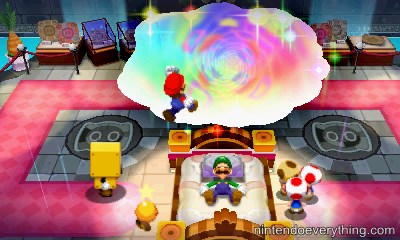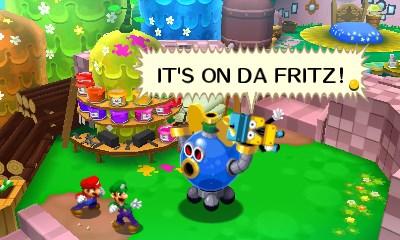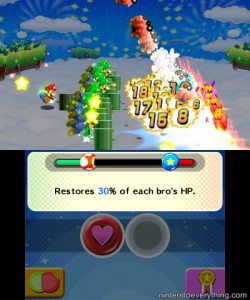[Review] Mario & Luigi: Dream Team (3DS)

System: Nintendo 3DS (and 2DS, I guess)
Release Date: August 11, 2013
Developer: AlphaDream
Publisher: Nintendo
Author: Patrick
Dream Team begins with Mario and Luigi off to enjoy a much-needed vacation at the sunny Pi’illo Island and this sets the tone for the rest of the game. It’s a refreshingly relaxed experience with a forgiving difficulty level, and chill bossa nova music courtesy of Yoko Shinomura. However, it’s also a bit too relaxed for its own good, as poor pacing and overbearing tutorials threaten to bring the adventure to a halt. Make no mistake – the latest in the Mario & Luigi series is still as fun as its predecessors, but it takes a lot of patience to get to the charming and creative parts.

After arriving on the sleep-themed Pi’illo island, the Mario Bros. find an ancient artifact (namely a crown-wearing cushion named Prince Dreambert) that allows Mario to explore the “dream world” that exists inside Luigi’s mind. Following a good old-fashioned kidnapping, the brothers have to explore both the island and Luigi’s dreams while tracking down the villainous Antasma and the petrified Pi’illos scattered around the place. In true Mario RPG style, the overarching plot doesn’t matter at all. That’s not to say that the writing is bad – it’s just focused on introducing ridiculous characters and being as funny as possible. I thought the humour in Dream Team was a bit of a step back from previous games in the series, but to its credit, there aren’t any parts where the writers (or more likely the localization team) came off as trying too hard to be funny like the “L33t Hamm3r Broz.” from Partners in Time. The way Mario and Luigi emote is still hilarious at times, but the story focuses too much on the Pi’illos. While the Pi’illos all have adorable designs, for the most part they really only serve to deliver bland exposition with very little comedy. Prince Dreambert in particular is a dull addition to the cast and even less interesting than the bunch of one-note characters like Broque Monsieur and Starlow that Dream Team insists on bringing back.

Mario and Luigi are controlled as a pair; they can jump, swing hammers and pull off other moves, which are all mapped to the simple control scheme of “A” for Mario, “B” for Luigi. It should be instantly familiar if you’ve played any other Mario & Luigi game, but things get a lot more interesting inside the side-scrolling Dream World. Since Luigi should be the most important part of his own dreams, he can enter various “Luiginary Works”, which are all activated by manipulating the sleeping Luigi on the lower screen. From scratching his nose and causing him to sneeze a massive gust of wind to moving his ‘stache around to control the flow of time, the Luiginary Works are all fun to use. Though none of the gameplay elements introduced by these moves are ever fully developed, it’s still a creative concept with lots of cute visual touches.

One thing I really liked about the previous Mario & Luigi game, Bowser’s Inside Story, was the way that the game was an exploration of Bowser in both the literal and figurative sense. I’d never call it an in-depth character study or anything, but it managed to put an interesting perspective on a well-known but not necessarily well-developed character. I was hoping that the dream world would serve a similar purpose, but there’s not really any exploration of Luigi’s character at all. In fact, aside from a brief expedition to the eerie Dream’s Deep, I never got the sense that I was exploring Luigi’s dreams rather than just an abstract depiction of areas from the overworld. Sure, the dream world makes for some interesting stages, especially when taking Luigi’s varied abilities into account, but it feels like wasted potential.
That said, the art direction in the dream world is absolutely phenomenal. Different layers create a unique atmosphere that suits the whimsical nature of the world perfectly. In fact, the visual style of Mario & Luigi: Dream Team as a whole is quote impressive. One issue I had with previous games in the series was that it was sometimes difficult to judge depth in both exploration and battles, but this is rectified by the fact that the environments are all rendered in 3D (of course, the effect is helped by the 3DS itself). All of the characters are still represented as sprites, but they’re much more detailed than before and fit naturally with the three-dimensional setting.

Mario & Luigi: Dream Team’s biggest issue is that the pacing is too slow. Switching between the real and dream worlds should create a nice flow between two fairly different play styles, but it ends up making areas take even longer to explore. Even areas like Mt. Pajamaja where the humour works and the enemy encounters are interesting are excruciating to get through simply because the brothers spend too much time there. At around 30 hours (plus plenty of sidequests) Dream Team is hardly the lengthiest RPG out there, but it feels longer than it should be, as the experience is padded by plenty of fetch quests.
Another reason why the game is so slowly paced is the overabundance of tutorials. Their presence makes sense – reportedly this was to address complaints in Club Nintendo surveys that previous games in the series didn’t explain things enough and there are certainly enough new gameplay mechanics worth covering. The problem is that they persist throughout the entire game, with some elements constantly explained even if you’ve seen them plenty of times (yes, even in the final dungeon). This overreliance on hand-holding reaches the point where several puzzles are presented only to have the solution handed to you on a silver platter, which begs the question of why they were even there in the first place. This explanation-heavy approach has good intentions, but there are plenty of other ways to make the game more accessible to newcomers without “dumbing down” the experience, as the battle system proves.

I’ve always found the battles in the Mario & Luigi games to be a much more elegant mix of traditional RPG combat and the skill-based platforming Mario is known for than, say, Paper Mario or Super Mario RPG. The fact that both attacking and defending requires constant input keeps things engaging and skilled players can breeze through battles without taking damage. As in Bowser’s Inside Story, the brothers can also equip different badges that can be activated in fights for a quick heal, status effects and other more creative effects, but there are much more badge combinations this time around. The brothers can now also select various passive bonuses such as an extra equipment slot, boosted experience rates and damage increases. These are only available whenever the brothers “rank” increases, meaning that equipping all of them is impossible, which adds an extra level of strategy and customization. Unlike the exploration sequences, the hand-holding is kept to a bare minimum and the fights quickly increase in difficulty. While the other Mario & Luigi games had you fighting Bowser as a tutorial boss, here he marks the point where the battles really start getting challenging. In fact, Dream Team is probably the most difficult game in the series, especially when taking into account the new (but unfortunately locked until clearing the game) hard mode.
It’s also simultaneously the easiest game in the series, as battles have been made much more accessible. Retrying fights doesn’t use up items anymore, and even gives you the option to temporarily switch to “easy mode” and provides hints on enemies’ attack patterns. Though some of the battles can be a bit obnoxious, it’s never because they’re too easy. Battles also contain a series of achievements, or “expert challenges”. Considering how varied enemies’ attack patterns are and the creative ways the brothers pull off counterattacks, it’s disappointing that the challenges boil down to merely scoring “Excellent” hits and avoiding sequences of consecutive attacks. Still, the rare gear obtained through the challenges does encourage fighting smarter and should give some incentive to not just avoid battles.

Fights in the Dream World quite literally add a new dimension to battles. Since Luigi can potentially do anything in his dreams, Mario fights by himself and follows up his attacks by calling in a satisfying swarm of Luigis. The Dream World battles have a similar dynamic to the Bowser fights in Bowser’s Inside Story, but with a heavier focus on crowd control and dodging attacks by actually moving Mario around. Just like the game’s usual Bros. Attacks, battles in the Dream World have special “Luiginary Attacks” – interactive techniques that involve things like rolling a bunch of Luigis into a ball or turning them into a tornado. Some of these take a bit too long to pull off, and the game definitely has an overreliance on using the 3DS gyro sensor, but they’re still a lot of fun to unleash.
There are also occasional battles that feature a gigantic Luigi squaring off against a boss while stomping around like Godzilla and destroying parts of the Dream World. In these fights Luigi only has a limited range of attacks and defending is really boils down to a number of minigames that would make Wario proud. Gimmicky? Absolutely, but the fact that the segments are so sparse means that they serve as welcome breaks from the usual gameplay. Again, it’s very similar to Bowser’s Inside Story, but the 3D presentation and the creative use of the console’s features (but thankfully not the microphone this time) keep it from feeling derivative.
Play this game if…
…You don’t mind taking things at a slow, slow pace and are after an accessible, entry-level RPG that favours skill over grinding.
Don’t play this game if…
…You absolutely can’t stand a game that bombards you with tutorials and have an allergy to cute things

–
Want to reach Patrick for some reason?
Try his twitter!
–
Want to participate in more NintendoEverything goodness?
Try our Facebook page!
Or our Twitter page!